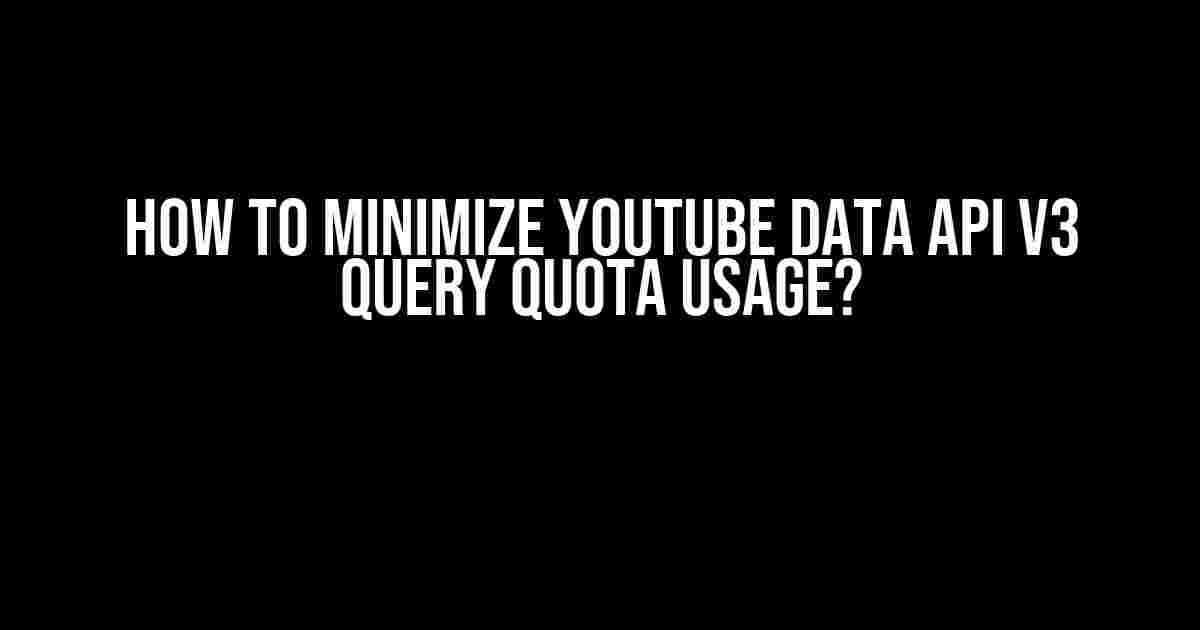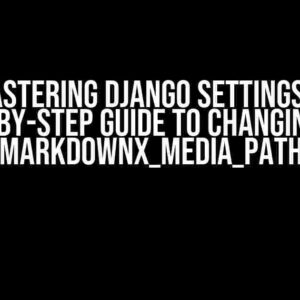Are you tired of hitting the YouTube Data API v3 query quota limit every time you try to fetch data for your application? Do you want to know the secrets to minimizing your quota usage and avoiding those frustrating error messages? Look no further! In this comprehensive guide, we’ll show you how to optimize your API queries and reduce your quota usage.
Understanding YouTube Data API v3 Quota Basics
Before we dive into the optimization techniques, it’s essential to understand how the YouTube Data API v3 quota system works. Here are the basics:
- Quota unit: A single quota unit represents a single API request or operation.
- Quota limits: The daily quota limit is 10,000 quota units per project, and 100 quota units per 100 seconds per user.
- Quota usage: You can check your quota usage in the Google Cloud Console.
- Quota reset: Quota limits reset at midnight Pacific Time (PT) every day.
Optimization Techniques to Minimize Quota Usage
Now that you understand the basics, let’s dive into the optimization techniques to minimize your quota usage:
1. Cache API Responses
Caching API responses is one of the most effective ways to reduce quota usage. By storing API responses in a cache, you can avoid making redundant requests to the API. Here’s an example using Node.js and Redis:
const redis = require('redis');
const client = redis.createClient();
async function getVideoDetails(videoId) {
const cachedResponse = await client.get(`video:${videoId}`);
if (cachedResponse) {
return JSON.parse(cachedResponse);
}
const response = await youtube.api.videos.list({
part: 'id,snippet',
id: videoId,
});
client.set(`video:${videoId}`, JSON.stringify(response));
return response;
}
2. Use API Keys with Limited Permissions
Creating API keys with limited permissions can help reduce quota usage. By limiting the permissions, you can restrict the scope of the API requests and reduce the quota usage. For example, if you only need to read video titles, create an API key with read-only permissions:
| Permission | Description |
|---|---|
https://www.googleapis.com/auth/youtube.force-ssl |
Read-only permission for YouTube API |
3. Implement Exponential Backoff
Exponential backoff is a technique used to handle API rate limiting. By implementing exponential backoff, you can slow down the rate of API requests and reduce quota usage. Here’s an example using Node.js:
const retry = require('retry');
async function makeApiRequest() {
const operation = retry.operation({
retries: 5,
minTimeout: 1000,
maxTimeout: 30000,
});
operation.attempt(() => {
return youtube.api.videos.list({
part: 'id,snippet',
id: videoId,
});
});
}
4. Use API Batch Requests
Batching API requests can significantly reduce quota usage. By batching multiple requests into a single API call, you can reduce the number of API requests and minimize quota usage. Here’s an example using the YouTube Data API v3 batch request:
const batchRequest = {
'https://www.googleapis.com/batch': {
requests: [
{
method: 'GET',
url: 'https://www.googleapis.com/youtube/v3/videos?part=id%2Csnippet&id=VIDEO_ID_1',
},
{
method: 'GET',
url: 'https://www.googleapis.com/youtube/v3/videos?part=id%2Csnippet&id=VIDEO_ID_2',
},
{
method: 'GET',
url: 'https://www.googleapis.com/youtube/v3/videos?part=id%2Csnippet&id=VIDEO_ID_3',
},
],
},
};
youtube.api.batch(batchRequest, (err, response) => {
if (err) {
console.error(err);
} else {
console.log(response);
}
});
5. Avoid Unnecessary API Requests
Avoid making unnecessary API requests by optimizing your application’s logic. Here are some tips:
- Delete unnecessary API requests.
- Optimize database queries to reduce the number of API requests.
- Use API responses to populate dropdowns and other UI elements.
Additional Tips and Best Practices
In addition to the optimization techniques mentioned above, here are some additional tips and best practices to minimize quota usage:
1. Use API Client Libraries
Using API client libraries can help reduce quota usage by providing an additional layer of abstraction and optimizing API requests. Here are some popular API client libraries:
- Google API Client Library for Node.js
- Google API Client Library for Python
- Google API Client Library for Java
2. Monitor Quota Usage
Monitoring quota usage is crucial to identifying areas of optimization. Use the Google Cloud Console or API client libraries to monitor quota usage and adjust your optimization strategies accordingly.
3. Implement Quota Alerts
Implementing quota alerts can help you stay on top of quota usage and avoid surprises. Set up alerts for high quota usage or errors to notify your team and take corrective action.
4. Use Quota-Free API Endpoints
Some API endpoints are quota-free, meaning they don’t consume quota units. Use quota-free endpoints whenever possible to reduce quota usage. Here are some examples:
GET https://www.googleapis.com/youtube/v3/videos?part=idGET https://www.googleapis.com/youtube/v3/channels?part=id
Conclusion
Minimizing YouTube Data API v3 query quota usage requires a combination of optimization techniques, best practices, and clever coding. By implementing caching, using API keys with limited permissions, exponential backoff, API batch requests, and avoiding unnecessary API requests, you can significantly reduce quota usage and avoid those frustrating error messages. Remember to monitor quota usage, implement quota alerts, and use quota-free API endpoints to stay on top of your API game.
Now, go ahead and optimize your API queries to minimize quota usage and take your application to the next level!
Frequently Asked Question
Optimizing YouTube Data API v3 query quota usage is crucial to avoid hitting the limits and incurring additional costs. Here are some frequently asked questions to help you minimize your query quota usage:
What is the most efficient way to fetch YouTube video metadata using the API?
To minimize quota usage, use the `part` parameter to specify only the metadata fields you need. For example, if you only need the video title and ID, use `part=id,snippet`. This reduces the amount of data transferred and processed, thereby reducing quota usage.
How can I reduce the number of API requests for retrieving video comments?
Use the `maxResults` parameter to fetch multiple comments in a single API request. You can set `maxResults` to a value up to 100, which is the maximum allowed. This reduces the number of API requests needed to retrieve comments, thereby minimizing quota usage.
What is the impact of caching on YouTube Data API v3 query quota usage?
Caching can significantly reduce quota usage by minimizing the number of API requests. Cache frequently accessed data, such as video metadata, to avoid redundant API requests. Implement a cache with a reasonable TTL (time to live) to ensure you’re not overloading the API with repeated requests.
Can I use API keys with a lower quota limit to reduce query quota usage?
Yes, you can create multiple API keys with different quota limits to control query quota usage. For example, you can create a key with a lower quota limit for development or testing purposes to avoid depleting your main API key’s quota. However, be cautious not to exceed the cumulative quota limit across all API keys.
How can I monitor and optimize my YouTube Data API v3 query quota usage?
Use the Google Cloud Console to monitor your API quota usage. Set up alerts and notifications to stay informed when your quota approaches the limit. Regularly review your API usage and optimize your code to minimize quota usage. Additionally, consider implementing a quota budgeting system to allocate resources efficiently.



